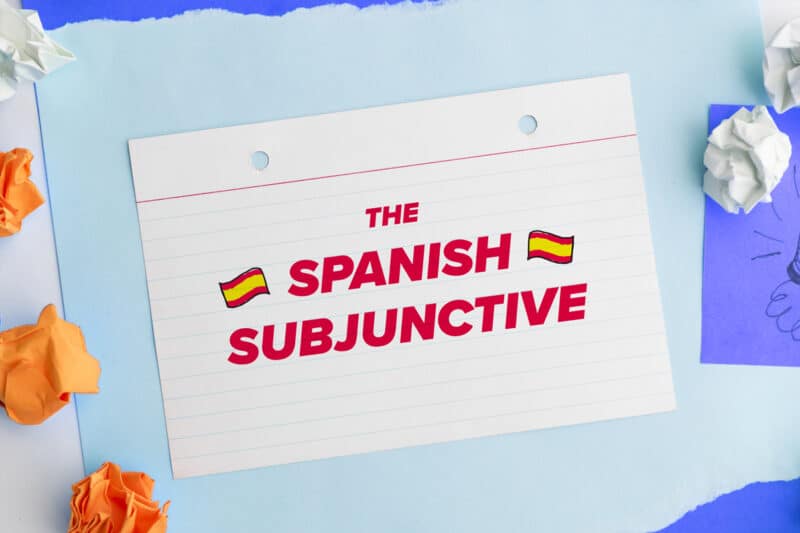How to Use the Spanish Subjunctive

For a long time, I couldn’t figure out the Spanish subjunctive. I was comfortable talking in the present tense but floundered whenever I tried to remember subjunctive conjugation. And sometimes I couldn’t even remember whether I was supposed to use the subjunctive in a given situation.
But the Spanish subjunctive isn’t as tricky as I thought. So in this post, I’m walking you through it so you can master it, too.
Download: This blog post is available as a convenient and portable PDF that you can take anywhere. Click here to get a copy. (Download)
What is the Spanish Subjunctive Mood?
There are three moods in Spanish: indicative, imperative and subjunctive.
The indicative is the most common mood that’s used to talk about facts and observations, while the imperative is used for commands, orders and instructions.
The subjunctive mood that we’re discussing today is used when expressing:
- Wishes, desires, doubts and guesses
- Emotions and possibilities
- Obligations or necessities
But first, what’s the difference between a mood and a tense?
A tense tells us when the action takes place. This place in time can be the past, the present or the future. On the other hand, a mood does not place the action at any moment in time—instead, it tells about how we feel about the action.
English vs. Spanish Subjunctive
While English speakers often have a lot of trouble with the subjunctive, English does have a subjunctive mood.
However, it’s far less common than in Spanish and more associated with formal speech and writing. Yet similar enough that it should provide a basis for understanding the Spanish subjunctive.
Think about the following sentences:
“If I were in your position, I would call the police.”
“The important thing is that you be here.”
“I wish I were a little bit taller.”
When to Use the Spanish Subjunctive
1. When You See Trigger Words
Specific trigger words tell you your sentence should be conjugated in the subjunctive.
For example, the subjunctive mood often occurs in subordinate clauses (clauses that cannot stand alone as a complete sentence) that begin with que:
Es probable que salgamos tarde. (It’s likely we’ll leave late).
Es bueno que tengas tiempo libre. (It’s good that you have free time).
Also notice the beginnings of the sentences: es probable and es bueno.
Some other common subjunctive triggers are:
- Es importante que… (it’s important that…)
- Dudar que… (to doubt that…)
- Es bueno que… (it’s good that…)
- Es malo que… (it’s bad that…)
- Esperar que… (to hope/wish that…)
- Es mejor que… (it’s better that…)
- Es raro que… (it’s strange that…)
- Es posible que… (it’s possible that…)
- Es probable que… (it’s likely that…)
- Es necesario que… (it’s necessary that…)
- Hasta que… (until…)
- Ojalá que… (hopefully…)
- No es seguro que… (it’s not certain that…)
- Mientras que… (meanwhile/while…)
- Sin que… (without…)
- Querer que… (to want to…)
2. In Specific Situations (Using the WEIRDO Method)
The WEIRDO Method is an excellent way of remembering six situations when the subjunctive is used in Spanish.
Here is what it stands for, plus some examples:
Wishes
Espero que se enamore de mí. (I hope she falls in love with me).
Emotions
Me encanta que me llames. (I love it when you call me).
Impersonal expressions
Es importante que vengas. (It is important that you come).
Recommendations
Te recomiendo que no bebas alcohol. (I recommend that you don’t drink alcohol).
Doubt/Denial
Dudo que tenga 30 años. (I doubt she is 30) / No creo que valga la pena. (I don’t think it’s worth it).
Ojalá (Hopefully)
Ojalá me toque la lotería. (I hope I’ll win the lottery).
3. When There Are Two Clauses with Different Subjects
If you have two clauses in a sentence and each of them has a different subject, use the indicative (or imperative, as appropriate) for the main clause and the subjunctive for the subordinate one.
Just as a quick refresher—a clause is a related group of words that contains a subject and a verb.
Now on to our examples:
(Yo) Quiero que (tú) digas la verdad. (I want you to tell the truth).
(Tú) Dile que (él) no vuelva. (Tell him not to come back).
(Nosotros) Necesitamos que Ana nos ayude. (We need Ana to help us).
4. To Express Future Probability, Intention and Speculation
Spanish also uses the subjunctive to express future probability, intention and speculation.
Apart from some of the expressions included in the Trigger Method that can be used for future purposes (like Es posible que…), there are two important situations when Spanish uses the subjunctive: Cuando (when) + a future action and in second conditionals (a type of conditional used to imagine situations that are realistically impossible or unlikely).
.Instead of using the future tense, use the subjunctive after cuando for future actions:
Te llamaré cuando vuelva. (I’ll call you when I’m back).
Cuando lleguemos a casa, haremos las maletas. (When we arrive home, we will pack).
Spanish uses “if + imperfect subjunctive, simple conditional” for second conditionals.
For example:
Si fuera rico, compraría una casa. (If I were rich, I would buy a house).
Si estudiaras más, aprobarías el examen. (If you studied more, you would pass the exam).
In the end, the best way to master the subjunctive is by practicing it, using it with native speakers and listening to Spanish media. The videos on FluentU, for instance, are a good option as they let you see the subjunctive in context.
FluentU takes authentic videos—like music videos, movie trailers, news and inspiring talks—and turns them into personalized language learning lessons.
You can try FluentU for free for 2 weeks. Check out the website or download the iOS app or Android app.
P.S. If you decide to sign up now, you can take advantage of our current sale!

How to Conjugate a Spanish Verb in the Subjunctive
Subjunctive conjugations are pretty straightforward, assuming you’ve already got your present indicative and imperative conjugations locked down.
All you need to do is follow two steps:
Step 1: Start with the verb stem used for the first person present tense
Step 2: Change the ending according to the subject (using the conjugation tables below). -Ar verbs end with -e,-es, -emos, -en, and -er/-ir verbs end with -a, -as, -amos, -an.
Here are some examples of indicative vs subjunctive forms:
Encuentro (I find) → Encuentre (I find)
Bailas (you dance) → Bailes (you dance)
Tienen (they have) → Tengan (they have)
Hacemos (we do/make) → Hagamos (we do/make)
Regular present subjunctive endings
Irregular verbs in the present subjunctive
There are only six verbs that are specifically irregular in the present subjunctive.
Common Mistakes with the Subjunctive
I’ve been teaching Spanish for 20 years now and I’ve found that 99% of my students make the same mistakes, have the same problems and are equally lost when studying the Spanish subjunctive.
But if you stick to the rules and follow all the information included in this post, you won’t have any problem with this mood. The subjunctive is only as difficult as you make it to be.
- Not every “que” triggers the subjunctive
There are countless situations where que is followed by the subjunctive, but this is only true if we have a subjunctive trigger or have to apply any of the methods described above.
Many times, que is just a “normal” que, and it will be followed by whatever it needs, not necessarily the subjunctive:
El niño que vive allí es alto. (The boy who lives there is tall).
Tengo que comprar agua. (I need to buy some water).
- There is a difference between “Creo que no” and “No creo que”
They look very similar, and they include the exact words in a different order, but while creo que no needs the indicative, no creo que needs the subjunctive:
Creo que no me amas. (I think you don’t love me).
No creo que me ames. (I don’t think you love me).
- “Aunque” can be used in the subjunctive or indicative
Aunque (even if/even though) can be followed by both the indicative and the subjunctive depending on the message you want to convey.
When using the word aunque, remember that fact = indicative and doubt/condition = subjunctive:
Aunque llueve, iremos al parque. (Even though it is raining, we will go to the park).
Aunque llueva, iremos al parque. (Even if it rains, we will go to the park).
- When in doubt, use the indicative
Chances are if you’re having difficulties deciding whether you should use the subjunctive, you don’t have to.
Granted, this is better advice if you’re having a conversation with friends than if you’re taking a DELE exam.
But still, if you have already decided to toss a coin, choose the indicative. Your friends won’t mind and will probably correct you.
It’s worth remembering that most subjunctive Spanish sentences still make sense without the subjunctive conjugation of the verb.
Spanish speakers will understand what you’re trying to say. So don’t stress out if you skip over a subjunctive.
You shouldn’t be afraid to throw a subjunctive conjugation in if it springs to mind! Even if you aren’t correct, you’ll probably be understood.
Download: This blog post is available as a convenient and portable PDF that you can take anywhere. Click here to get a copy. (Download)
And One More Thing…
If you've made it this far that means you probably enjoy learning Spanish with engaging material and will then love FluentU.
Other sites use scripted content. FluentU uses a natural approach that helps you ease into the Spanish language and culture over time. You’ll learn Spanish as it’s actually spoken by real people.
FluentU has a wide variety of videos, as you can see here:

FluentU brings native videos within reach with interactive transcripts. You can tap on any word to look it up instantly. Every definition has examples that have been written to help you understand how the word is used. If you see an interesting word you don’t know, you can add it to a vocab list.

Review a complete interactive transcript under the Dialogue tab, and find words and phrases listed under Vocab.

Learn all the vocabulary in any video with FluentU’s robust learning engine. Swipe left or right to see more examples of the word you’re on.

The best part is that FluentU keeps track of the vocabulary that you’re learning, and gives you extra practice with difficult words. It'll even remind you when it’s time to review what you’ve learned. Every learner has a truly personalized experience, even if they’re learning with the same video.
Start using the FluentU website on your computer or tablet or, better yet, download the FluentU app from the iTunes or Google Play store. Click here to take advantage of our current sale! (Expires at the end of this month.)







